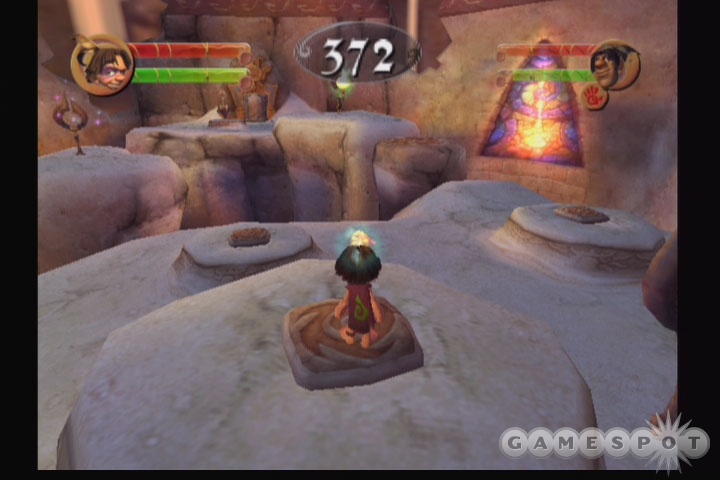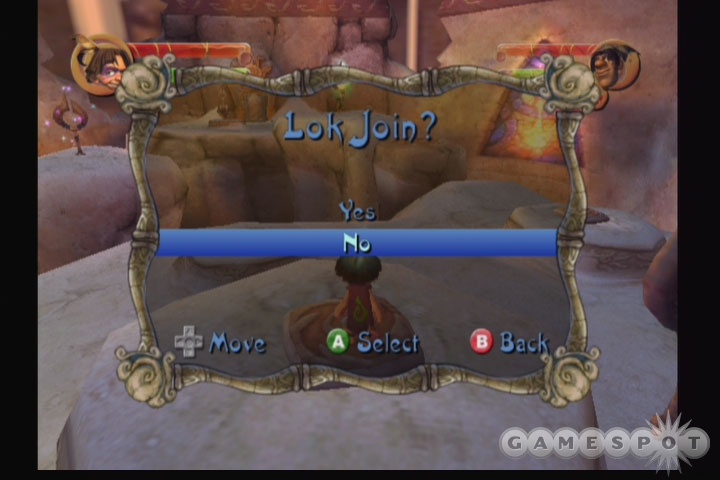Tak 3: The Great Juju Challenge is the third iteration of the Nickelodeon-fueled Tak franchise, which focuses on a young (or maybe he's old--but he's certainly cute either way) tribal boy named Tak and his dopey buddy Lok. The story centers around a competition that happens once each generation, called, you guessed it, The Great Juju Challenge, which tasks competitors with completing various levels, competing in vehicle destruction challenges, beating the clock, and scoring the maximum number of points. The gameplay focuses on the balance between Tak and Lok's different moves and how they work together, and you can play single-player with the computer's help, or you can play split-screen cooperative mode with another player. Tak 3 certainly has some adorable moments, but they're overshadowed by a frustrating design and sloppy gameplay mechanics. If you're looking for a fun and interesting platform experience that won't infuriate you, you can do much better than Tak 3.
The Great Juju Challenge is a contest held every 60 years in which teams of two vie for the favor of the Moon Juju goddess. The teams accrue points through a successful combination of defeating enemies and building up the time limit on each level. This year, Tak and Lok have been chosen to represent the Pupanunu tribe and must compete against three other pairs, Team JibbaJabba, Team Grammazon, and the nefarious Team Black Mist. Although Tak and Lok are the underdogs, they have a fair number of moves between them, as well as the skills to take the whole competition...at least when the other teams aren't cheating. The story is, in fact, one of the best aspects of Tak 3, since the dynamic between the two characters and how they interact with others is quite cute. Lok is especially charming in the way that dimwitted characters always manage to be endearing. Though things seem to go wrong for Tak and Lok on a pretty consistent basis, you're guaranteed to root for them from the get-go.

There are a number of individual moves and combination moves that make the gameplay varied, at the very least. Tak (the smaller of the two characters) can swim, be tossed around, and is pretty adept with magic. Lok (the muscle) can climb vines, throw Tak and barrels, and has a special relationship with gorillas. In one particularly amusing sequence during the training section, Lok tells Tak that he won't get in the water. It's not because he's afraid or can't swim, but it's because fish hate him. The camera then cuts to a fish who's giving Lok a deadpan scowl, and the sentiment is absolutely conveyed. Later on in the game, both players get the opportunity to change into different costumes, which opens up new abilities to them. Lok uses a lobster suit, and thus is able to go underwater and can pinch at things while he's submerged. Tak's chicken suit lets him ride air vents into the sky, where he can then launch egg grenades. It's in these moments of hilarity and utter cuteness that Tak 3 becomes truly endearing. It's unfortunate, then, that there's so much sloppy gameplay around to remind you otherwise.
Each level is relatively linear, except there are certain areas that one character can reach and not the other. The two must work together to both find all the checkpoints and flag them so they can progress through and eventually unlock the exit. Some puzzles require the two players to work together, and often this means that Lok must toss Tak up to a cliff that's virtually unreachable. Many such checkpoints that necessitate this maneuver ensure that both players are going through the game at the same pace. All this is good in theory, but it doesn't work well in the game. One of its greatest flaws is since the game is designed to be played by both individual players and two players cooperatively, it isn't specifically optimized for either. In single-player, you can switch which character you control, meaning you can do everything (if you desire).
The problem is that if you attempt to do everything yourself, it will be a long and tedious process full of busywork. Then again, the computer artificial intelligence isn't that great, so relying on a computer companion is a lesson in patience. For example, we found a couple of patches in the game where your computer-controlled teammate will just run into a thorny bush, losing health the whole time. If you play two-player, however, the game's action is halved, so you'll often find yourself just standing around waiting on a switch while your friend does something else. Of the two, cooperative is the preferable option, and it's truly one of the game's few accomplishments, if only because of its unique implementation. Tak 3: The Great Juju Challenge's greatest technical achievement is that you can swap the second player in and out of gameplay on the fly, without all the pesky requirements of menu navigation. Simply stick in the second controller, pause the game, and select "Lok Join." The screen splits down the middle, and the two of you are off. Even though there are some technical difficulties with the mode pertaining to dying and respawn locations, the pain of the game is a lot more bearable when you have a good buddy to share it with.

Further working against Tak 3 is the game's general sloppiness. The graphics are mediocre, and the cutscenes in all three versions often look poorly compressed. The textures and color palette are just plain boring, which is unfortunate, because there's so much potential within the franchise. The best thing going for the graphics are the facial animations during the cutscenes. But even they don't redeem an otherwise muddy-looking game. The graphics are only slightly better on the Xbox and GameCube versions, keeping them still below average for their respective platforms. The presentation gets a pick-me-up in the sound department, though, and everything about the game's aural atmosphere is great. The voice work is well articulated and acted. The music, from the soft tribal beats in the earlier levels, to the rockin' '80s metal jams in the last ones, is fitting and well executed. We even like the sound effects, though we're not too certain that's what a baby rhino sounds like.
Throughout the game's four worlds, both players get spells that make playing much easier. Tak can grapnel Lok across wide gaps (typically when there's water that Lok won't swim through), freeze enemies, summon a trio of violent spirits, and conjure up an exploding barrel that Lok can then throw. Lok, on the other hand, can heal, shield, taunt, and, finally, stink, which is exactly as foul as it sounds. If these abilities weren't enough to get you through the game, you can also upgrade both characters' statistics by placing blessings on them. Scattered through the worlds, typically in the side-quest areas of each level, are recipes that teach Tak and Lok how to make blessing gems. Once the recipe is found, the player can use fruits, crystals, and insects collected from breaking superfluous items on the levels to make a gem. The gem is then placed on Tak or Lok's gem slots, but this can only be done in the level hub.

The one aspect of the game that disrupts Tak 3: The Great Juju Challenge's gameplay more than any other is the point requirement between the levels. Each of the four worlds has three levels within it (except the last one, which has only two). After you've completed the three levels in the world, you must go through the "Proving Grounds," a vehicular combat level that knocks the lowest-scoring team out of the competition. However, to enter the Proving Grounds, you're required to have a minimum score. If you explored the levels and didn't rush through them, you probably ran out of time, even though there are a number of hourglass pickups on the levels to extend it. The game lets you continue without the timer, though your point total will be exponentially lower. Because of this, you'll find that you have to play through almost every level in the game twice to properly progress. The first time you'll figure out exactly what you're doing and where you need to go, and the second time you'll execute everything quickly and try not to run out of time. Considering this game is supposed to specifically target children, this mechanic is completely baffling. And since the levels aren't particularly fun the first time around, playing through a second time is infuriating.
Despite its occasional cute moments and the compelling aspects of the cooperative mode, Tak 3 is more frustrating than anything else. The gameplay seems unfocused and doesn't work optimally for either single players or pairs. We even encountered a couple of level-stopping bugs during our play-through of the game. Tak 3: The Great Juju Challenge has a few worthwhile features, but overall, the risk is much greater than the reward. This is the go-to platformer for co-op, but there are plenty of other platformers that are go-to for fun.